torque FIAT DOBLO COMBI 2017 2.G Owners Manual
[x] Cancel search | Manufacturer: FIAT, Model Year: 2017, Model line: DOBLO COMBI, Model: FIAT DOBLO COMBI 2017 2.GPages: 300, PDF Size: 24.91 MB
Page 105 of 300

BRAKE ASSIST
(integrated ESP
emergency braking
assistance)
(for versions/markets, where provided)
This system (which cannot be
deactivated) recognises emergency
braking conditions according to the
speed of operation of the brake pedal
and provides an additional hydraulic
braking pressure to support that
provided by the driver. This allows
faster and more powerful operation of
the braking system.
Brake Assist is deactivated on the
versions equipped with ESP, in the
event of ESC system failure (indicated
by the
warning light coming on
together with a message in the
multifunction display, where provided).
WARNING
53)When the ABS cuts in and you feel the
brake pedal pulsating, do not remove
your foot, but keep the pedal pushed
down; in doing so you, will stop in the
shortest distance possible under the road
conditions at the time.
54)If the ABS system intervenes, this
indicates that the traction of the tyres on
the road is nearing its limit. You must slow
down to a speed compatible with the
available traction.55)The ABS gets the most from the
available grip, but it cannot improve it; you
should therefore take every care when
driving on slippery surfaces and not take
unnecessary risks.
56)If only the
instrument panel
warning light comes on (with a message in
the multifunction display on some
versions), stop the vehicle immediately and
contact the nearest Fiat Dealership. Any
loss of fluid will affect the brake system
functionality, both conventional and
ant-lock wheels.
ESC (Electronic
Stability Control)
SYSTEM
(for versions/markets, where provided)
IN BRIEF
This is an electronic system that
controls vehicle stability in the event
of tyre grip loss, helping to maintain
directional control.
The ESC system is therefore
particularly useful when grip
conditions of road surfaces change.
The MSR system (adjustment of
the engine braking torque during gear
changes) and the HBA system
(automatic increase in the braking
pressure during emergency braking)
are present with ESC, ASR and
Hill Holder systems (for
versions/markets where provided).
SYSTEM INTERVENTION
This is signalled by the flashing of the
warning light in the instrument panel,
to inform the driver that the vehicle is
in critical stability and grip conditions.
101
Page 106 of 300
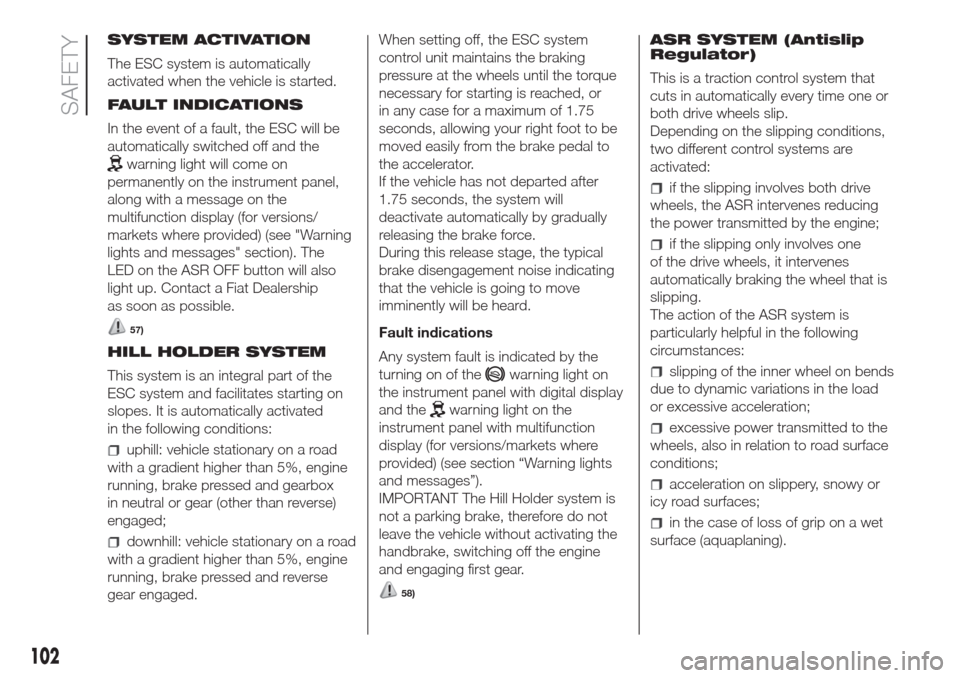
SYSTEM ACTIVATION
The ESC system is automatically
activated when the vehicle is started.
FAULT INDICATIONS
In the event of a fault, the ESC will be
automatically switched off and the
warning light will come on
permanently on the instrument panel,
along with a message on the
multifunction display (for versions/
markets where provided) (see "Warning
lights and messages" section). The
LED on the ASR OFF button will also
light up. Contact a Fiat Dealership
as soon as possible.
57)
HILL HOLDER SYSTEM
This system is an integral part of the
ESC system and facilitates starting on
slopes. It is automatically activated
in the following conditions:
uphill: vehicle stationary on a road
with a gradient higher than 5%, engine
running, brake pressed and gearbox
in neutral or gear (other than reverse)
engaged;
downhill: vehicle stationary on a road
with a gradient higher than 5%, engine
running, brake pressed and reverse
gear engaged.When setting off, the ESC system
control unit maintains the braking
pressure at the wheels until the torque
necessary for starting is reached, or
in any case for a maximum of 1.75
seconds, allowing your right foot to be
moved easily from the brake pedal to
the accelerator.
If the vehicle has not departed after
1.75 seconds, the system will
deactivate automatically by gradually
releasing the brake force.
During this release stage, the typical
brake disengagement noise indicating
that the vehicle is going to move
imminently will be heard.
Fault indications
Any system fault is indicated by the
turning on of the
warning light on
the instrument panel with digital display
and the
warning light on the
instrument panel with multifunction
display (for versions/markets where
provided) (see section “Warning lights
and messages”).
IMPORTANT The Hill Holder system is
not a parking brake, therefore do not
leave the vehicle without activating the
handbrake, switching off the engine
and engaging first gear.
58)
ASR SYSTEM (Antislip
Regulator)
This is a traction control system that
cuts in automatically every time one or
both drive wheels slip.
Depending on the slipping conditions,
two different control systems are
activated:
if the slipping involves both drive
wheels, the ASR intervenes reducing
the power transmitted by the engine;
if the slipping only involves one
of the drive wheels, it intervenes
automatically braking the wheel that is
slipping.
The action of the ASR system is
particularly helpful in the following
circumstances:
slipping of the inner wheel on bends
due to dynamic variations in the load
or excessive acceleration;
excessive power transmitted to the
wheels, also in relation to road surface
conditions;
acceleration on slippery, snowy or
icy road surfaces;
in the case of loss of grip on a wet
surface (aquaplaning).
102
SAFETY
Page 107 of 300
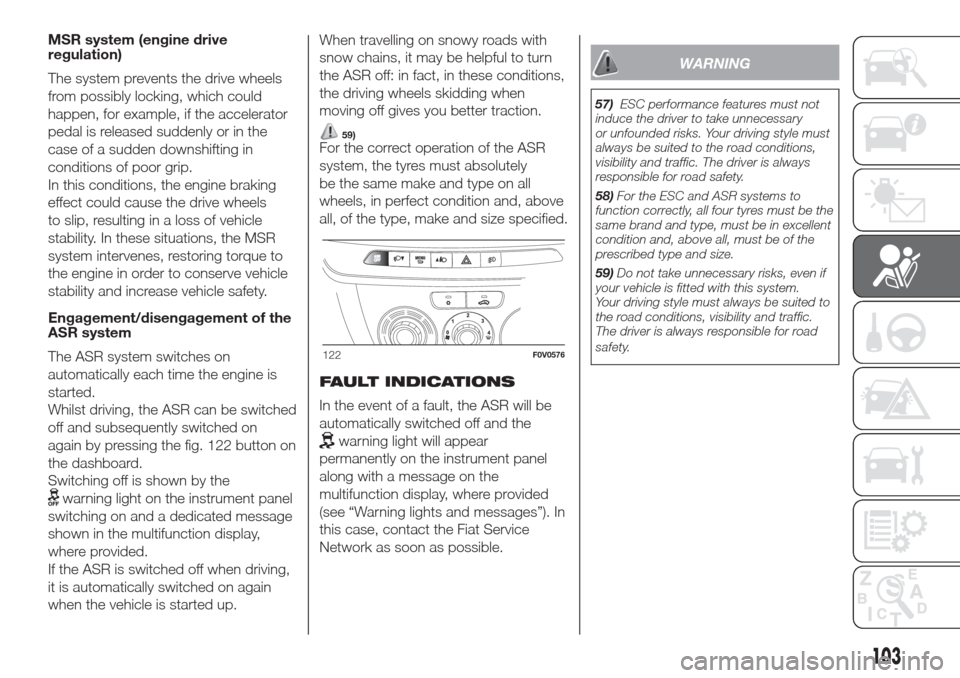
MSR system (engine drive
regulation)
The system prevents the drive wheels
from possibly locking, which could
happen, for example, if the accelerator
pedal is released suddenly or in the
case of a sudden downshifting in
conditions of poor grip.
In this conditions, the engine braking
effect could cause the drive wheels
to slip, resulting in a loss of vehicle
stability. In these situations, the MSR
system intervenes, restoring torque to
the engine in order to conserve vehicle
stability and increase vehicle safety.
Engagement/disengagement of the
ASR system
The ASR system switches on
automatically each time the engine is
started.
Whilst driving, the ASR can be switched
off and subsequently switched on
again by pressing the fig. 122 button on
the dashboard.
Switching off is shown by the
warning light on the instrument panel
switching on and a dedicated message
shown in the multifunction display,
where provided.
If the ASR is switched off when driving,
it is automatically switched on again
when the vehicle is started up.When travelling on snowy roads with
snow chains, it may be helpful to turn
the ASR off: in fact, in these conditions,
the driving wheels skidding when
moving off gives you better traction.
59)For the correct operation of the ASR
system, the tyres must absolutely
be the same make and type on all
wheels, in perfect condition and, above
all, of the type, make and size specified.
FAULT INDICATIONS
In the event of a fault, the ASR will be
automatically switched off and the
warning light will appear
permanently on the instrument panel
along with a message on the
multifunction display, where provided
(see “Warning lights and messages”). In
this case, contact the Fiat Service
Network as soon as possible.
WARNING
57)ESC performance features must not
induce the driver to take unnecessary
or unfounded risks. Your driving style must
always be suited to the road conditions,
visibility and traffic. The driver is always
responsible for road safety.
58)For the ESC and ASR systems to
function correctly, all four tyres must be the
same brand and type, must be in excellent
condition and, above all, must be of the
prescribed type and size.
59)Do not take unnecessary risks, even if
your vehicle is fitted with this system.
Your driving style must always be suited to
the road conditions, visibility and traffic.
The driver is always responsible for road
safety.
122F0V0576
103
Page 143 of 300

TRACTION PLUS
SYSTEM
(for versions/markets, where provided)
Traction Plus is a driving aid, useful
for setting off in poor grip conditions
(snow, ice, mud, etc.) which allows the
drive force to be distributed in the
best way over the front axle when one
wheel is slipping.
Traction Plus acts by braking the
wheels with poor grip (or those slipping
more than the others), thereby
transferring the drive force to those
which have greater grip on the ground.
This function can be activated manually
by pressing the A fig. 154 button on
the control panel and operates under
50 km/h. When this speed is exceeded,
it is automatically deactivated and it is
reactivated again when the speed
falls below 50 km/h.Traction Plus operation
The system is deactivated when
starting. To activate the Traction Plus
system press the A fig. 154 button.
The activation of the Traction Plus
system involves the following functions
being switched on:
inhibition of the ASR function, in
order to fully exploit the engine torque;
the differential locking effect on
the front axle, through the braking
system, to improve traction on irregular
grounds.
If the Traction Plus system is faulty, the
warning light on the instrument
panel switches on constantly.
PARKING SENSORS
These are located in the rear bumper
fig. 155 and their function is to inform
the driver, through an intermittent
beeping noise, about the presence of
obstacles behind the vehicle.
ACTIVATION
The sensors are automatically activated
when reverse is engaged. As the
obstacle behind the vehicle gets closer
to the bumper, the frequency of the
acoustic signal increases.
ACOUSTIC SIGNAL
When reverse gear is engaged an
intermittent acoustic signal is
automatically activated.
The frequency of the acoustic signal:
increases as the distance between
the vehicle and the obstacle decreases;
154F0V0575
155F0V0077
139
Page 148 of 300
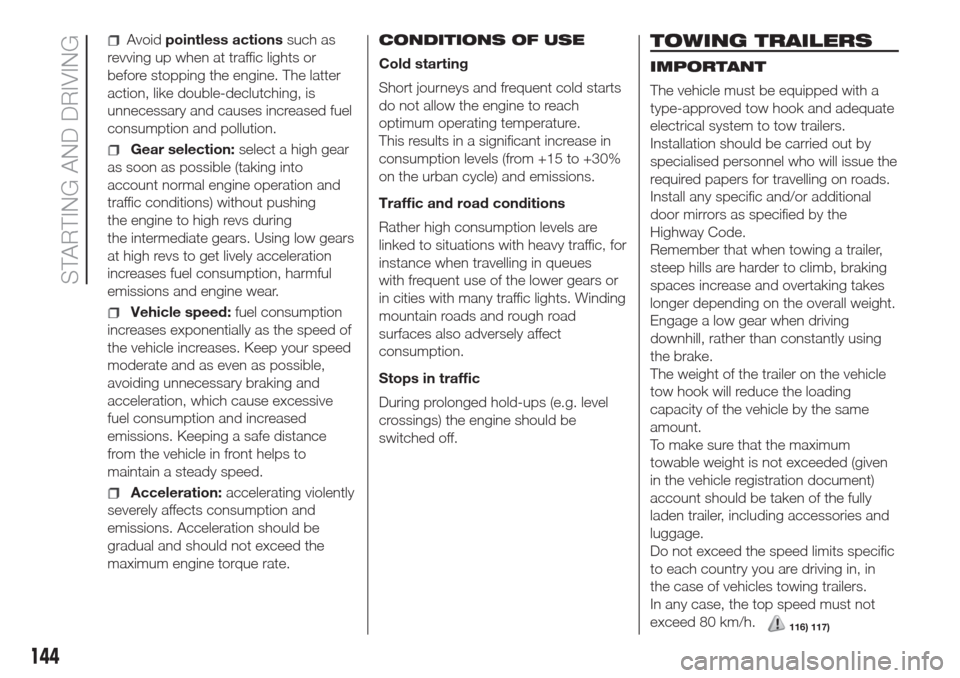
Avoidpointless actionssuch as
revving up when at traffic lights or
before stopping the engine. The latter
action, like double-declutching, is
unnecessary and causes increased fuel
consumption and pollution.
Gear selection:select a high gear
as soon as possible (taking into
account normal engine operation and
traffic conditions) without pushing
the engine to high revs during
the intermediate gears. Using low gears
at high revs to get lively acceleration
increases fuel consumption, harmful
emissions and engine wear.
Vehicle speed:fuel consumption
increases exponentially as the speed of
the vehicle increases. Keep your speed
moderate and as even as possible,
avoiding unnecessary braking and
acceleration, which cause excessive
fuel consumption and increased
emissions. Keeping a safe distance
from the vehicle in front helps to
maintain a steady speed.
Acceleration:accelerating violently
severely affects consumption and
emissions. Acceleration should be
gradual and should not exceed the
maximum engine torque rate.CONDITIONS OF USE
Cold starting
Short journeys and frequent cold starts
do not allow the engine to reach
optimum operating temperature.
This results in a significant increase in
consumption levels (from +15 to +30%
on the urban cycle) and emissions.
Traffic and road conditions
Rather high consumption levels are
linked to situations with heavy traffic, for
instance when travelling in queues
with frequent use of the lower gears or
in cities with many traffic lights. Winding
mountain roads and rough road
surfaces also adversely affect
consumption.
Stops in traffic
During prolonged hold-ups (e.g. level
crossings) the engine should be
switched off.
TOWING TRAILERS
IMPORTANT
The vehicle must be equipped with a
type-approved tow hook and adequate
electrical system to tow trailers.
Installation should be carried out by
specialised personnel who will issue the
required papers for travelling on roads.
Install any specific and/or additional
door mirrors as specified by the
Highway Code.
Remember that when towing a trailer,
steep hills are harder to climb, braking
spaces increase and overtaking takes
longer depending on the overall weight.
Engage a low gear when driving
downhill, rather than constantly using
the brake.
The weight of the trailer on the vehicle
tow hook will reduce the loading
capacity of the vehicle by the same
amount.
To make sure that the maximum
towable weight is not exceeded (given
in the vehicle registration document)
account should be taken of the fully
laden trailer, including accessories and
luggage.
Do not exceed the speed limits specific
to each country you are driving in, in
the case of vehicles towing trailers.
In any case, the top speed must not
exceed 80 km/h.
144
STARTING AND DRIVING
116) 117)
Page 212 of 300
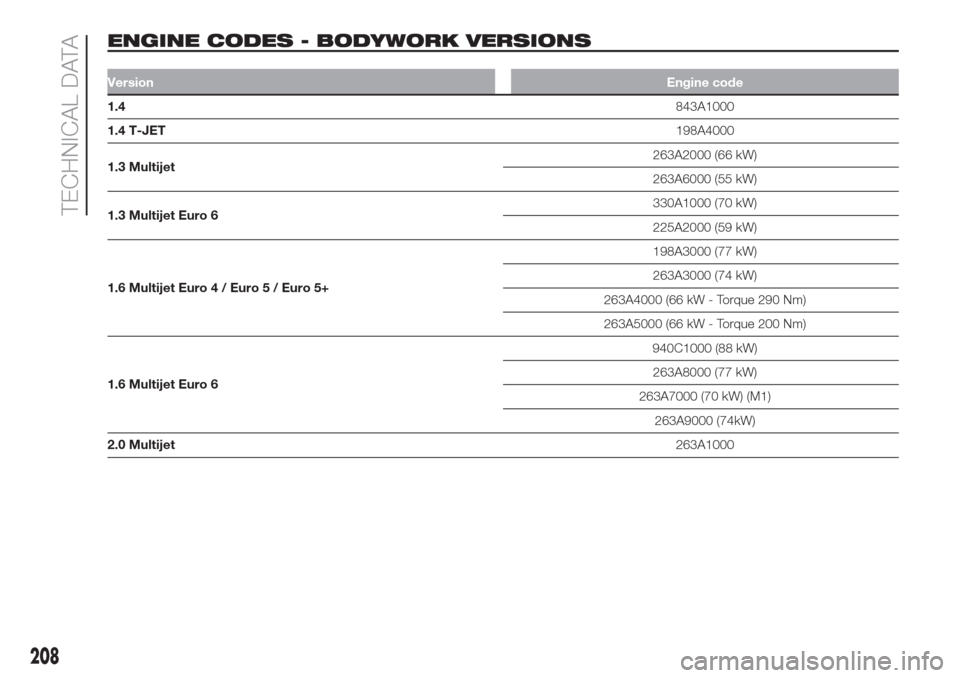
ENGINE CODES - BODYWORK VERSIONS.
VersionEngine code
1.4843A1000
1.4 T-JET198A4000
1.3 Multijet263A2000 (66 kW)
263A6000 (55 kW)
1.3 Multijet Euro 6330A1000 (70 kW)
225A2000 (59 kW)
1.6 Multijet Euro 4 / Euro 5 / Euro 5+198A3000 (77 kW)
263A3000 (74 kW)
263A4000 (66 kW - Torque 290 Nm)
263A5000 (66 kW - Torque 200 Nm)
1.6 Multijet Euro 6940C1000 (88 kW)
263A8000 (77 kW)
263A7000 (70 kW) (M1)
263A9000 (74kW)
2.0 Multijet263A1000
208
TECHNICAL DATA
Page 213 of 300
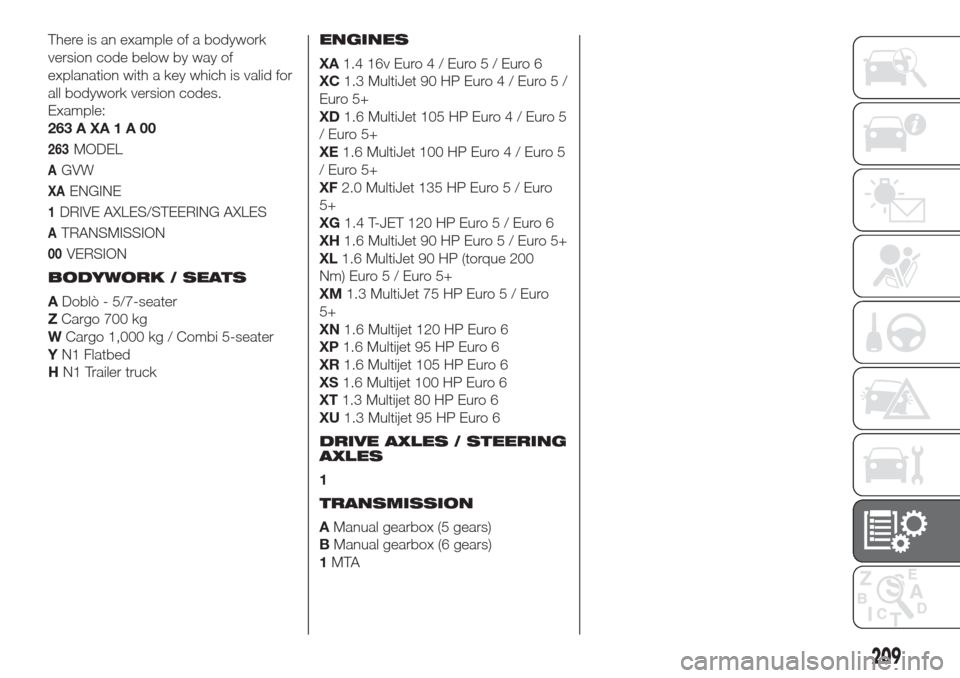
There is an example of a bodywork
version code below by way of
explanation with a key which is valid for
all bodywork version codes.
Example:
263AXA1A00
263MODEL
AGVW
XAENGINE
1DRIVE AXLES/STEERING AXLES
ATRANSMISSION
00VERSION
BODYWORK / SEATS
ADoblò - 5/7-seater
ZCargo 700 kg
WCargo 1,000 kg / Combi 5-seater
YN1 Flatbed
HN1 Trailer truckENGINES
XA1.4 16v Euro 4 / Euro 5 / Euro 6
XC1.3 MultiJet 90 HP Euro4/Euro5/
Euro 5+
XD1.6 MultiJet 105 HP Euro4/Euro5
/ Euro 5+
XE1.6 MultiJet 100 HP Euro4/Euro5
/ Euro 5+
XF2.0 MultiJet 135 HP Euro 5 / Euro
5+
XG1.4 T-JET 120 HP Euro5/Euro6
XH1.6 MultiJet 90 HP Euro5/Euro5+
XL1.6 MultiJet 90 HP (torque 200
Nm) Euro 5 / Euro 5+
XM1.3 MultiJet 75 HP Euro 5 / Euro
5+
XN1.6 Multijet 120 HP Euro 6
XP1.6 Multijet 95 HP Euro 6
XR1.6 Multijet 105 HP Euro 6
XS1.6 Multijet 100 HP Euro 6
XT1.3 Multijet 80 HP Euro 6
XU1.3 Multijet 95 HP Euro 6
DRIVE AXLES / STEERING
AXLES
1
TRANSMISSION
AManual gearbox (5 gears)
BManual gearbox (6 gears)
1MTA
209
Page 214 of 300
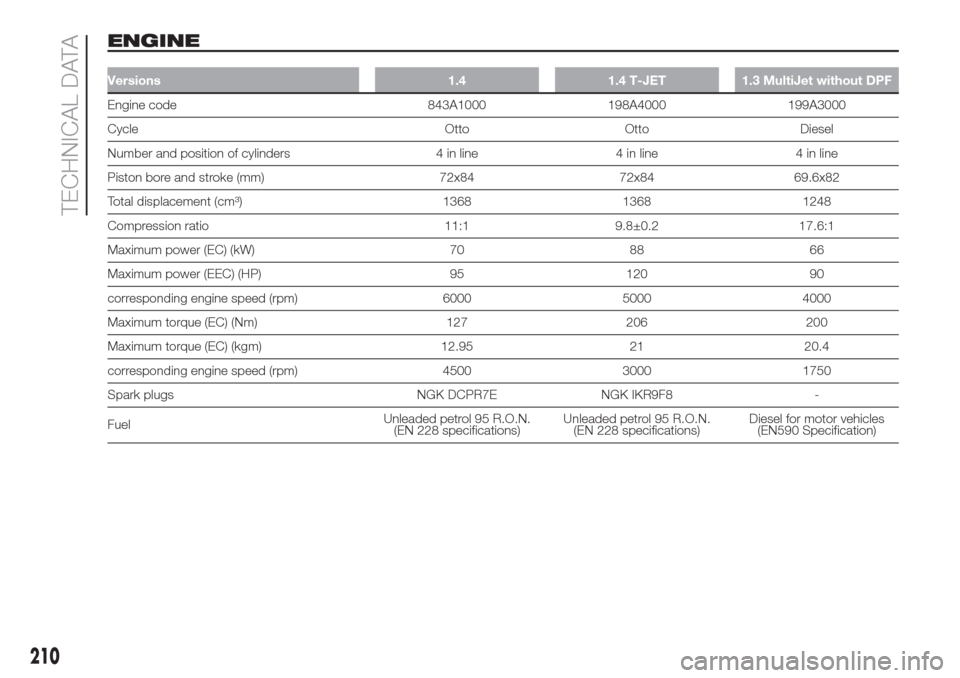
ENGINE
Versions 1.4 1.4 T-JET 1.3 MultiJet without DPF
Engine code 843A1000 198A4000 199A3000
Cycle Otto Otto Diesel
Number and position of cylinders 4 in line 4 in line 4 in line
Piston bore and stroke (mm) 72x84 72x84 69.6x82
Total displacement (cm³) 1368 1368 1248
Compression ratio 11:1 9.8±0.2 17.6:1
Maximum power (EC) (kW) 70 88 66
Maximum power (EEC) (HP) 95 120 90
corresponding engine speed (rpm) 6000 5000 4000
Maximum torque (EC) (Nm) 127 206 200
Maximum torque (EC) (kgm) 12.95 21 20.4
corresponding engine speed (rpm) 4500 3000 1750
Spark plugs NGK DCPR7E NGK IKR9F8 -
FuelUnleaded petrol 95 R.O.N.
(EN 228 specifications)Unleaded petrol 95 R.O.N.
(EN 228 specifications)Diesel for motor vehicles
(EN590 Specification)
210
TECHNICAL DATA
Page 215 of 300
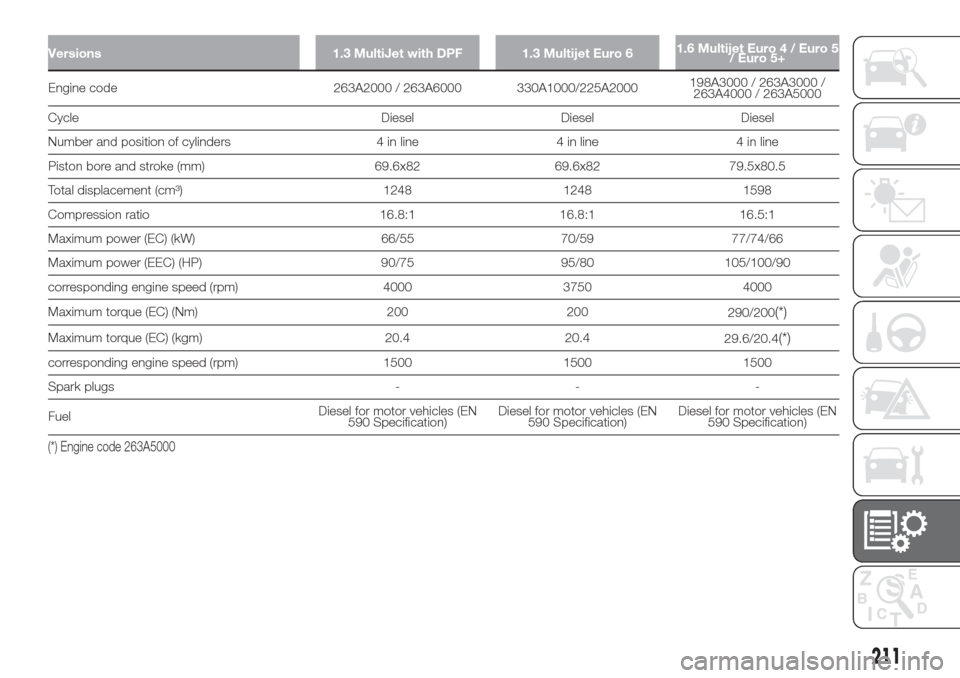
Versions 1.3 MultiJet with DPF 1.3 Multijet Euro 61.6 Multijet Euro 4 / Euro 5
/ Euro 5+
Engine code 263A2000 / 263A6000 330A1000/225A2000198A3000 / 263A3000 /
263A4000 / 263A5000
Cycle Diesel Diesel Diesel
Number and position of cylinders 4 in line 4 in line 4 in line
Piston bore and stroke (mm) 69.6x82 69.6x82 79.5x80.5
Total displacement (cm³) 1248 1248 1598
Compression ratio 16.8:1 16.8:1 16.5:1
Maximum power (EC) (kW) 66/55 70/59 77/74/66
Maximum power (EEC) (HP) 90/75 95/80 105/100/90
corresponding engine speed (rpm) 4000 3750 4000
Maximum torque (EC) (Nm) 200 200
290/200
(*)
Maximum torque (EC) (kgm) 20.4 20.4
29.6/20.4(*)
corresponding engine speed (rpm) 1500 1500 1500
Spark plugs - - -
FuelDiesel for motor vehicles (EN
590 Specification)Diesel for motor vehicles (EN
590 Specification)Diesel for motor vehicles (EN
590 Specification)
(*) Engine code 263A5000
211
Page 216 of 300
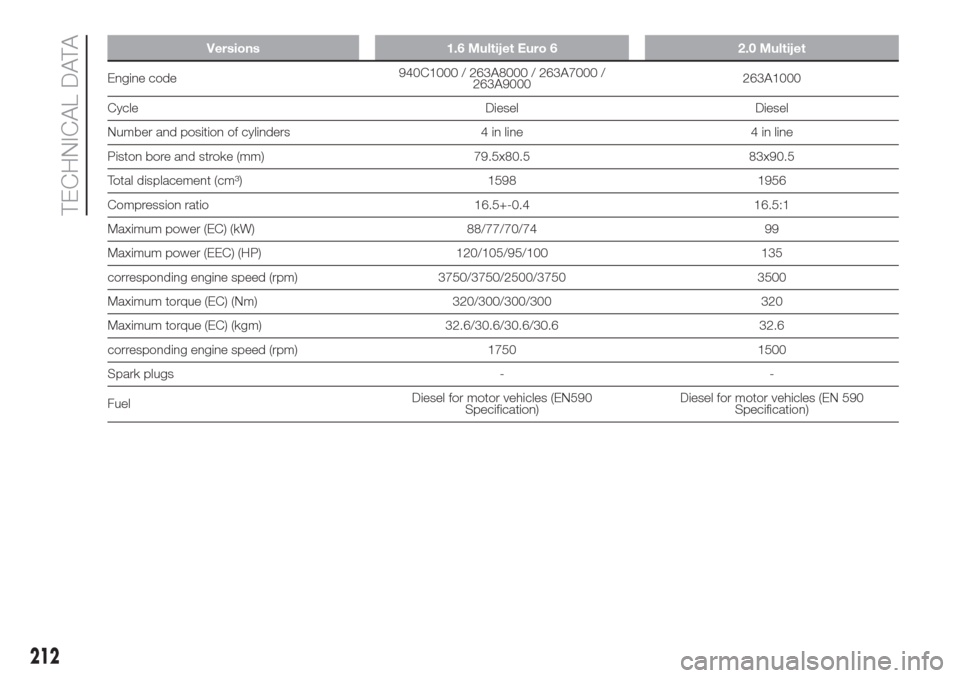
Versions 1.6 Multijet Euro 6 2.0 Multijet
Engine code940C1000 / 263A8000 / 263A7000 /
263A9000263A1000
Cycle Diesel Diesel
Number and position of cylinders 4 in line 4 in line
Piston bore and stroke (mm) 79.5x80.5 83x90.5
Total displacement (cm³) 1598 1956
Compression ratio 16.5+-0.4 16.5:1
Maximum power (EC) (kW) 88/77/70/74 99
Maximum power (EEC) (HP) 120/105/95/100 135
corresponding engine speed (rpm) 3750/3750/2500/3750 3500
Maximum torque (EC) (Nm) 320/300/300/300 320
Maximum torque (EC) (kgm) 32.6/30.6/30.6/30.6 32.6
corresponding engine speed (rpm) 1750 1500
Spark plugs - -
FuelDiesel for motor vehicles (EN590
Specification)Diesel for motor vehicles (EN 590
Specification)
212
TECHNICAL DATA